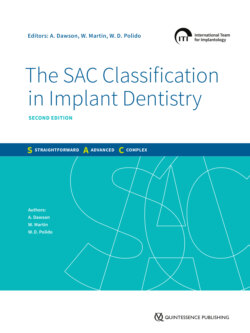The SAC Classification in Implant Dentistry

Реклама. ООО «ЛитРес», ИНН: 7719571260.
Оглавление
Группа авторов. The SAC Classification in Implant Dentistry
The SAC Classification in Implant Dentistry
Foreword. The SAC Classification in Implant Dentistry
Acknowledgments
Editors / Authors
Contributors
Table of Contents
CHAPTER 1: Introduction to the Updated SAC Classification
1.1 Introduction
1.2 Historical Background
1.3 The Review Team
1.4 Potential Roles for the SAC Classification
1.5 Using this Book
CHAPTER 2: The Rationale Behind the Updated SAC Classification
2.1 Definitions
2.2 Assumptions
2.3 Is the Clinician a Risk Factor?
2.3.1 Factors impacting the clinician as a risk factor. 2.3.1.1 EXPERIENCE
2.3.1.2 TRAINING
2.3.1.3 SELF-ASSESSMENT OF ABILITY
2.3.1.4 SHARED LEARNING
2.3.1.5 SHORT TRAINING COURSES
2.3.1.6 STRUCTURED EDUCATION AND TRAINING
2.3.2 Reducing clinician-related risk. 2.3.2.1 RECOGNIZING “HUMAN FACTOR” RISKS
2.3.2.2 STRESS AS A RISK FACTOR
2.3.2.3 MITIGATING THE HUMAN FACTOR ISSUES
2.3.2.4 CLINICIAN RISK FACTOR IN RELATION TO OTHER SOURCES OF risks
2.4 Classification Rationale
CHAPTER 3: Risks in Implant Dentistry
3.1 Principles of Risk Management
3.2 The SAC Classification as a Risk Management Tool
3.3 General Risks
3.3.1 Patient medical factors
3.3.1.1 MEDICAL FITNESS
3.3.1.2 MEDICATIONS
3.3.1.3 RADIATION
3.3.1.4 GROWTH STATUS
3.3.2 Patient attitudes/behaviors. 3.3.2.1 SMOKING HABIT
3.3.2.2 COMPLIANCE
3.3.2.3 ORAL HYGIENE
3.3.2.4 PATIENT EXPECTATIONS
3.3.3 Site-related factors. 3.3.3.1 PERIODONTAL STATUS
3.3.3.2 ACCESS
3.3.3.3 PREVIOUS SURGERIES IN THE PLANNED IMPLANT SITE
3.3.3.4 NEARBY PATHOLOGY
3.4 Esthetic Risk
3.4.1 Medical status and smoking habit
3.4.2 Gingival display at full smile
3.4.3 Width of the edentulous space
3.4.4 Shapes of tooth crowns
3.4.5 Restorative status of adjacent teeth
3.4.6 Gingival phenotype
3.4.7 Volume of surrounding tissues
3.4.8 Patient’s esthetic expectations
3.5 Edentulous Esthetic Risk Assessment (EERA)
3.5.1 Facial support
3.5.2 Labial support
3.5.3 Upper lip length
3.5.4 Buccal corridor
3.5.5 Smile line
3.5.6 Maxillomandibular relationship
3.6 Surgical Risks
3.6.1 Anatomy
3.6.1.1 BONE VOLUME – HORIZONTAL
3.6.1.2 BONE VOLUME – VERTICAL
3.6.1.3 PRESENCE OF KERATINIZED TISSUE
3.6.1.4 QUALITY OF SOFT TISSUES
3.6.1.5 PROXIMITY TO VITAL ANATOMICAL STRUCTURES
3.6.2 Adjacent teeth
3.6.2.1 PAPILLA
3.6.2.2 RECESSION
3.6.2.3 INTERPROXIMAL ATTACHMENT
3.6.3 Extractions
3.6.3.1 RADICULAR MORPHOLOGY / INTERRADICULAR BONE
3.6.3.2 ALVEOLAR AND BASAL BONE MORPHOLOGY
3.6.3.3 SOCKET WALLS
3.6.3.4 THICKNESS OF FACIAL WALL
3.6.3.5 ANTICIPATED RESIDUAL DEFECT AFTER IMPLANT PLACEMENT
3.6.3.6 QUALITY AND QUANTITY OF SOFT TISSUES
3.6.4 Surgical complexity
3.6.4.1 TIMING OF PLACEMENT
3.6.4.2 GRAFTING PROCEDURES
3.6.4.3 NUMBER OF IMPLANTS
3.7 Prosthetic Risks
3.7.1 Restorative site factors
3.7.1.1 PROSTHETIC VOLUME
3.7.1.2 INTEROCCLUSAL SPACE
3.7.1.3 VOLUME AND CHARACTERISTICS OF THE EDENTULOUS RIDGE
3.7.2 Occlusal factors
3.7.2.1 OCCLUSAL SCHEME
3.7.2.2 INVOLVEMENT IN OCCLUSION
3.7.2.3 OCCLUSAL PARAFUNCTION
3.7.3 Complexity of process
3.7.3.1 ACCESS
3.7.3.2 INTERIM PROSTHESIS
3.7.3.3 IMPLANT-SUPPORTED PROVISIONAL RESTORATION
3.7.3.4 NUMBER AND LOCATION OF IMPLANTS
3.7.3.5 LOADING PROTOCOLS
3.7.4 Complicating factors
3.7.4.1 BIOLOGIC
3.7.4.2 MECHANICAL AND TECHNICAL
3.7.4.3 MAINTENANCE
CHAPTER 4: How Does the SAC Assessment Tool Derive a Classification?
4.1 Introduction
4.2 Definitions
4.3 Workflow
4.3.1 General risk assessment (GRA)
4.3.2 Esthetic risk assessment (ERA)
4.3.2.1 ERA
4.3.2.2 EERA
4.3.3 Surgical risk assessment (SRA) and surgical classification
4.3.4 Prosthodontic risk assessment (PRA) and prosthodontic classification
4.4 Calculating a Classification
4.4.1 Calculation mechanism
4.5 Testing the Algorithm
4.6 Presenting the Results
CHAPTER 5: Practical Application of the SAC Assessment Tool
5.1. Introduction
5.2 Implants for Restoration of Single-Tooth Spaces: Areas of Low Esthetic Risk. 5.2.1 Mandibular molar
5.2.2 Mandibular molar
TREATMENT PLANNING
SURGERY
RESTORATIVE
REFLECTION
5.3 Implants for Restoration of Single-Tooth Spaces: Areas of High Esthetic Risk. 5.3.1 Maxillary central incisor
TREATMENT PLANNING
SURGERY
RESTORATIVE
REFLECTION ON THE TREATMENT APPROACH AND OUTCOME
5.3.2 Maxillary lateral incisor
TREATMENT PLANNING
SURGICAL PROCEDURE
PROSTHETIC PROCEDURE
CONCLUSIONS
5.4 Implants in Extraction Sockets: Single Rooted Teeth. 5.4.1 Maxillary central incisor
TREATMENT PLANNING
SURGERY
IMMEDIATE PROVISIONAL
PROSTHETICS
REFLECTION ON THE TREATMENT APPROACH AND OUTCOME
5.4.2 Maxillary premolar
TREATMENT PLANNING
SURGERY
RESTORATIVE
REFLECTION
5.5 Implants in Extraction Sockets: Multirooted Teeth. 5.5.1 Maxillary first molar
CLINICAL AND RADIOGRAPHIC EXAMINATION
TREATMENT RISK PROFILE
TREATMENT PLANNING
SURGICAL TREATMENT
PROSTHETIC TREATMENT
DELIVERY OF THE DEFINITIVE RECONSTRUCTION AND FOLLOW-UP
DISCUSSION
5.6 Implants for Restoration of Short Edentulous Spaces: Areas of Low Esthetic Risk. 5.6.1 Adjacent maxillary premolars
INTRODUCTION AND PRELIMINARY ASSESSMENT
PROSTHODONTIC ASSESSMENT AND TREATMENT OPTIONS
SURGICAL ASSESSMENT
SAC ASSESSMENT
SURGICAL PHASE
PROSTHODONTIC PHASE
REFLECTION AND DISCUSSION
5.7 Implants for Restoration of Short Edentulous Spaces: Areas of High Esthetic Risk. 5.7.1 Adjacent maxillary incisors
CLINICAL EXAMINATION
DIAGNOSTIC PROTOCOL
TREATMENT RISK PROFILE
TREATMENT PLANNING
SURGICAL TREATMENT: IMPLANT PLACEMENT AND SIMULTANEOUS GBR
PROVISIONAL REMOVABLE PROSTHESIS
IMPLANTS UNCOVERING
PROVISIONAL SCREW-RETAINED RECONSTRUCTION
DEFINITIVE PROSTHETIC RECONSTRUCTION
FOLLOW-UP
DISCUSSION
5.8 Implants for Restoration of Long Edentulous Spaces: Areas of High Esthetic Risk. 5.8.1 Maxillary lateral and central incisors
TREATMENT PLANNING
SURGICAL PROCEDURE
SURGERY AND PROSTHETIC PROCEDURE
PROSTHETIC PROCEDURE
CONCLUSIONS
5.9 Implants for Restoration of Long Edentulous Spaces: Removable Prostheses. 5.9.1 Maxilla
SAC RISK ASSESSMENT. General risk assessment
Surgical classification
Prosthodontic classification
Edentulous esthetic risk assessment for removable dentures
REFLECTION AND FOLLOW-UP
5.10 Implants for Restoration of the Full Arch: Removable. 5.10.1 Edentulous maxilla: Bar-supported overdenture
TREATMENT RISK ASSESSMENT
PLANNING AND CLINICAL TREATMENT
REFLECTION ON THE TREATMENT APPROACH AND OUTCOME
5.10.2 Edentulous maxilla: Zygomatic implant bar-supported overdenture
SURGICAL TREATMENT PLANNING AND PROCEDURE
SURGICAL TREATMENT
REFLECTION ON THE TREATMENT APPROACH AND OUTCOME
5.11 Implants for Restoration of the Full Arch: Fixed. 5.11.1 Edentulous mandible: Fixed dental prosthesis
CLINICAL AND RADIOGRAPHIC EXAMINATION
DIAGNOSTIC PROTOCOL
TREATMENT RISK PROFILE
TREATMENT PLANNING
SURGICAL TREATMENT
IMMEDIATE LOADING PROSTHETIC PHASES
DENTAL LABORATORY PROCEDURES
DELIVERY OF THE FIXED RECONSTRUCTION
FOLLOW-UP
DISCUSSION
5.11.2 Edentulous maxilla and mandible: Implant-supported all-ceramic fixed complete dentures
TREATMENT RISK ASSESSMENT
PLANNING AND CLINICAL TREATMENT
REFLECTION ON THE TREATMENT APPROACH AND OUTCOME
ACKNOWLEDGEMENT
CHAPTER 6: Conclusion
CHAPTER 7: References
Отрывок из книги
The SAC Classification in Implant Dentistry
SECOND EDITION
.....
Division of Maxillofacial Surgery
University of Turin
.....